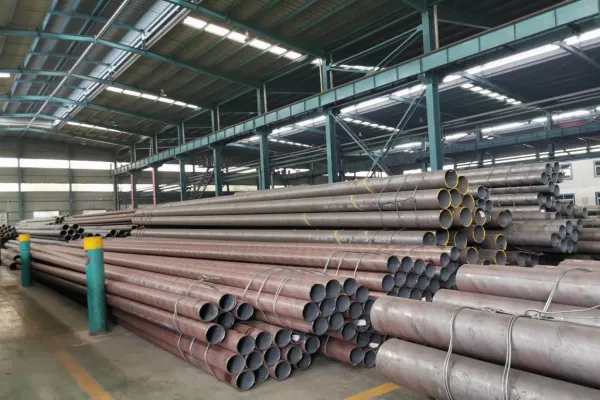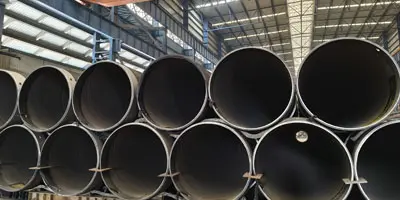What is hot-rolled seamless steel pipe?
Seamless steel pipe is made of a whole round steel through perforation, and the steel pipe without weld on the surface is called seamless steel pipe. According to the production method, seamless steel pipe can be divided into hot-rolled seamless steel pipe, cold-rolled seamless steel pipe, cold-drawn seamless steel pipe, extruded seamless steel pipe and jacking pipe.Hot-rolled seamless steel pipe is a large category of seamless steel pipes, which are divided according to the production method. Hot rolling is relative to cold rolling, which is rolling at room temperature, while hot rolling is rolling above the recrystallization temperature. Seamless steel pipe is relative to welded steel pipe. Seamless steel pipe is usually made by perforating round steel and then processing, while welded steel pipe is usually made by welding steel plates in different ways.
Hot rolled seamless steel pipe specifications(Outer diameter x wall thickness)
|
Small diameter
|
Medium caliber
|
Large caliber
|
|
12×1.5
|
73×4-4.5-5-6-7-8-9-10-12-15
|
219×30-40
|
|
14×1.5-2.5-3
|
76×4-4.5-5-6-7-8-9-10-12-14
|
245×8-10-14-17-20-22
|
|
16×1.5-2.5-4
|
83×4.5-5-10/ 12 14 16 18 20
|
245×25-28-30-34-40
|
|
18×2.3-4-5
|
89×4.5-8-10/12-14 16 -18 20
|
273×7-9-12-15-18-20-25
|
|
20×2.5-3-5
|
95×4.5-6-8/10-12-14-16-20
|
273×30-35-38-40
|
|
24×2.5-3-4-5-6
|
102×4.5-5-6-7-8-10-12-14-16-20
|
299×8-12-16-20-24-28
|
|
25×2.5-3-4-5-6
|
108×4.5-5-6-7-8-10/12-14-18-20-22
|
299×30-32-36-38-40
|
|
28×3-3.5-4-5-6
|
114×4.5-5-6-7-8-10-12-14-18-20
|
325×8-12-14-18-38
|
|
32×3.5-4-5-6-8
|
121×4.5-5-6-7-8-10-12-14-16-20
|
325×28-32-34-38
|
|
34×4-5-6-8
|
127×4.5-5-6-7-8-10-12-14-16-20
|
351×10-16-20-25-40
|
|
36×3.5-5-6-8
|
133×4.5-6-8-12-14-16-18-20-25-30
|
355×6-18-20-25-30-40
|
|
38×4-5-6-7-8-9-10
|
140×5-6-7-8-9-10/12-14-16-20-22
|
377×8-12-15-20-24-28
|
|
39×3.5-5-8-10
|
146×4.5-6-8-12-14-16-18-20-25-30
|
377×30/37/40
|
|
42×3.5-4-5-6-7-8-9-10
|
152×4.5-6-8-12-14-16-18-20-25-30
|
402×10/15-20-25-30-35
|
|
45×3.5-4-5-6-7-8-9
|
159×4.5-6-10-12-14
|
406×10/20-25-28-35-40
|
|
48×3.5-4-5-6-7-8-9-10
|
159×16-18-20-22-25-30
|
426×10/12-14-16-20-25-30-35-40
|
|
51×3.5-4-5-6-7-8-9-10
|
168×8-10/12/14/20/25/30/35
|
450×10/12-14-16-20-25-34-40
|
|
56×3.5-4-5-6-7-8-9-10
|
180×8-12-16-25-30
|
480×10/ 12 14 16 18 20 25 30 40
|
|
57×3.5-5-6-7-8-9-10-12
|
180×32-34-38-40
|
500×10/12-14-16-20-25-34-40
|
|
60×3.5-4.5-5-6-7-8-9-12-14
|
194×6-8-12-16-20-25-30-40
|
510×10/12-14-16-20-25-34-40
|
|
63×3.5-4.5-5-6-7-8-9-10-12-14
|
203×6-7-10-15-20-25-30
|
530×10/ 12 14 16 18 20 30-40
|
|
68×4-4.5-5-6-7-8-9-10-12-14-16
|
203×32-36-40
|
-
|
|
70×4-4.5-5-6-7-8-9-10-12-15-16
|
219×6-8-12-16-18-20-25
|
-
|
Standard outer diameter allowable deviation:
D1±1.5%, minimum ±0.75mm
D2±1.0%. ±0.50mm
D3±0.75%, minimum ±0.30mm
D4±0.50%. ±0.10mm
Steel pipe weight calculation formula
[(outer diameter-wall thickness)*wall thickness]x0.02466=kg/m (weight per meter)

Key Specifications of Hot Rolled Seamless Steel Pipes
The specifications of hot rolled seamless steel pipes vary depending on the material, size, and application. Here are the key parameters you need to know:
1.Material Grades
The material grade of a hot rolled seamless steel pipe is one of the most important specifications. Common grades include:
ASTM A106: A carbon steel grade widely used in high-temperature applications.
ASTM A53: Another common grade used in construction and industrial applications.
API 5L: Standard used for line pipes in the oil and gas industry.
DIN 17175: A German standard for seamless pipes used in boiler and heat exchanger applications.
2.Dimensions
Hot rolled seamless steel pipes come in various dimensions, typically specified by the outer diameter (OD) and wall thickness. Common ranges include:
Outer Diameter (OD): From 1/8 inch (6.35 mm) to 24 inches (610 mm) or more.
Wall Thickness: Can range from 0.5 mm to over 50 mm, depending on the pressure and strength requirements.
Length: Standard lengths are usually 6 meters or 12 meters, but custom lengths can be produced.
3.Pressure Rating
The pressure rating of a hot rolled seamless steel pipe indicates its ability to handle pressure without failure. This depends on the material grade, wall thickness, and the manufacturing process. It’s essential to choose a pipe with the appropriate pressure rating for your specific application to ensure safety and efficiency.
4.Mechanical Properties
The mechanical properties of hot rolled seamless steel pipes include tensile strength, yield strength, and elongation. These properties are crucial to determine the performance of the pipe under different loads and stresses. For example, ASTM A106 pipes typically offer a minimum tensile strength of 60,000 PSI, while the yield strength is around 35,000 PSI.
5.Surface Finish
Hot rolled seamless steel pipes are typically available with a smooth, clean surface finish. However, some applications may require additional surface treatments, such as galvanization, painting, or coating to enhance corrosion resistance.
Implementation standards for hot-rolled seamless steel pipes
There are many implementation standards for hot-rolled seamless steel pipes at home and abroad. Here are several commonly used standards:
1. GB/T8162-2008 "Seamless Steel Pipes-Structural Steel Pipes" standard: Applicable to seamless steel pipes for general structures and mechanical structures.
2. GB/T3087-2008 "
Seamless Steel Pipes-Steel Pipes for Low and Medium Pressure Boilers" standard: Applicable to seamless steel pipes for low and medium pressure boiler tube.
3. ASTM A106-2018 "Seamless carbon steel pipes for High Temperature Service" standard: Applicable to conveying media at elevated temperatures.
4. EN 10210-1: Seamless steel pipes for structures for various purposes, including machinery manufacturing, construction and bridge engineering.
5. JIS G3441-1994 "Alloy Steel Tubes for Machine Purposes" standard: Applicable to fields such as machine and automobile manufacturing.
Common materials for hot-rolled seamless steel pipes: 10#, 20#, 45#, 16Mn, 27SiMn, 12Cr1Mo, 15CrMo, etc.
Each standard has its scope of application and technical parameters, and need to pay attention when selecting standards according to specific needs.






 English
English Español
Español بالعربية
بالعربية











 Phone :
Phone :  Whatsapp :
Whatsapp :  Email :
Email : 


